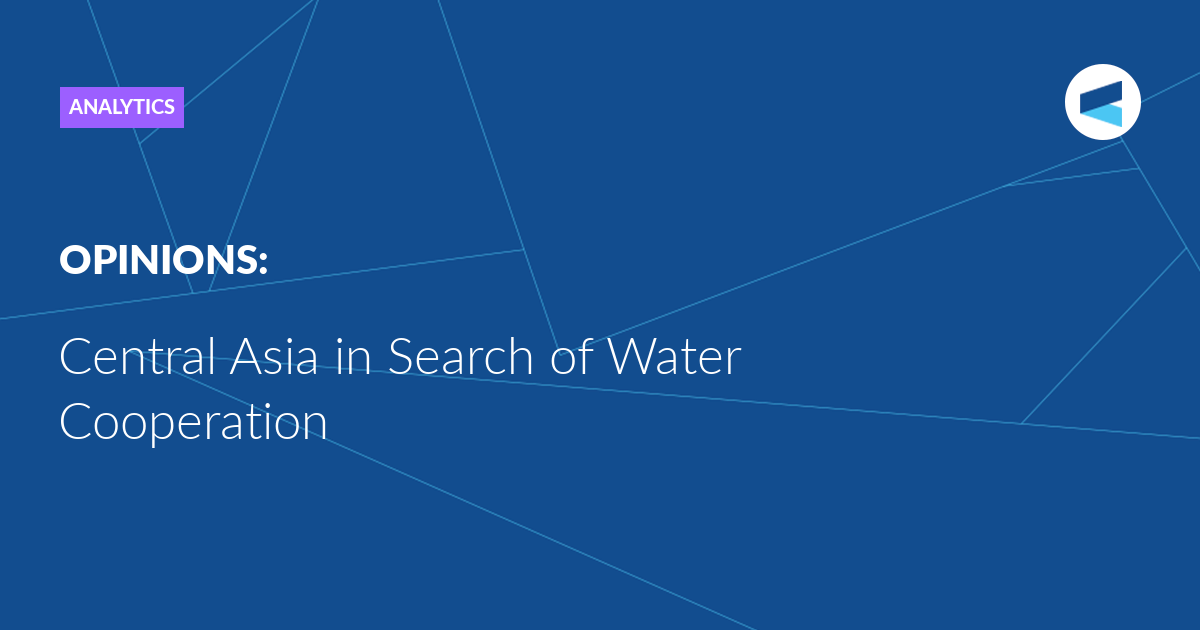The freshwater situation is becoming increasingly politicised. We can confidently say that the hydrological and political issues are gradually converging and will soon form complementary categories, write
Alexey Mikhalev and Kubatbek Rakhimov for the 4th Central Asian conference of the Valdai Discussion Club.
Central Asia is one region where the future of the water supply can already be traced. While there are more challenges in this region than in many others, what is particularly noteworthy is the increasing intensity of the political debate surrounding water. Discussions on climate change, agricultural expansion requiring irrigation, industrial production, and ultimately, hydropower, are merely the backdrop for broader geopolitical shifts. These shifts are driving the countries of the region toward both conflict and cooperation. Leo Mechnikov, a European scholar of Russian origin and an expert on Asian affairs, as well as one of the “founding fathers of Russian geopolitics,” once envisioned such cooperation. He is the author of the theory of cooperation, which states that both forced and free unions (two forms of cooperation) arise out of physiological necessity, resulting from the inability of each individual or member to exist independently without communication and cooperation with others. As an advocate for progress, Mechnikov contended that the future belongs to free alliances, based on creativity.
In the Central Asian region, the construction of hydroelectric power stations, canals and ditches, as well as new drainage, irrigation and land-reclamation systems require large-scale interstate cooperation. Today there are about a dozen cooperation projects in the field of water resources, but they are at different degrees of implementation. The most comprehensive (and long put in force) is the work of the Interstate Commission for Water Coordination of Central Asia. This commission determines the volume of water withdrawals for the countries of the region during the growing season. This body was created in 1992 as part of an agreement between Turkmenistan, Uzbekistan, Kazakhstan, Tajikistan and Kyrgyzstan on cooperation in the field of joint management and the protection of water resources. The contribution of the Commission to the development of cooperation in the water sector has been considerable. However, rapid changes in the climate and economies of the countries have created a need for additional forms of cooperation. Water consumption increases alongside the increase in agricultural land, and along with this, water losses also increase, exacerbating environmental problems. A clear trend towards cooperation in the field of water use can be observed in Central Asia at the moment. It is based on political trust between partners, which must be maintained. And so, for example, in 2024, on the border of Uzbekistan and Tajikistan, it was decided to update the system of gauging stations that measure water discharge and control its volumes.
According to experts from the Eurasian Development Bank (EDB), the average age of irrigation infrastructure in Central Asia exceeds 50 years, and about 40% of water is lost in the drainage of irrigation canals. Digitalisation and the use of space technology in this area make it possible to obtain more complete and timely data on the amount of water losses. However, trust is based on numbers, and cooperation is based on trust.
Russia is also interested in promoting regional cooperation within the framework of the EAEU (Eurasian Economic Union) and supporting small hydropower projects in Kyrgyzstan. As part of this initiative, a partnership is expected to be established in the construction of several small hydroelectric power plants in various regions of Kyrgyzstan, including Talas, Jalal-Abad, and Batken, among others. These projects will serve as the foundation for the development of an energy system that can generate significantly increased volumes of electricity for both the individual country and the region as a whole. This project is being carried out with the involvement of subsidiaries from the Rosatom corporation.
The development of cooperation between Kazakhstan, Kyrgyzstan, and Uzbekistan continues at the regional level. An example is the construction of the Kambarata Hydroelectric Power Plant (HPP)-1 in Kyrgyzstan on the Naryn River. The three countries have announced their intention to sign an agreement on this matter, and the documents are currently undergoing public discussion. The proposed agreement would establish a joint-stock company, with 34% ownership in the company belonging to Kyrgyzstan and 33% apiece to Kazakhstan and Uzbekistan. Upon completion of the project, it is planned that all assets of the hydroelectric facility will be transferred to Kyrgyzstan. A feasibility study for this project was conducted by a consortium, composed of the Canadian company SNC-Lavalin International Inc. and the Russian company Southern Engineering Centre of Energy. The estimated cost of construction of the hydroelectric plant at 2014 exchange rates was $2.9 billion dollars.
Initially, the concept of constructing the Kambarata hydropower plant originated in the USSR during the 1960s. Subsequently, a decision was made to construct not one but three plants. Eventually, in 1986, work commenced on Kambrata hydropower plants 1 and 2, which ceased in 1993 amidst the dissolution of the USSR and the onset of market reforms. Only in March 2021, it was announced that work would resume, with completion anticipated in ten years’ time, although the initial hydraulic unit is scheduled for commissioning in 2028. Nevertheless, it is concerning that the primary emphasis is placed through the mechanisms of the Asian Development Bank, World Bank, and a number of other international financial organisations, where Russia’s representation or role is either non-existent or not significant. Considering that the initial construction of the Kambarata hydropower plant was undertaken by the Russian party until the unilateral withdrawal by the Kyrgyz Republic, this may represent a source of potential conflict in projects related to connecting the water and energy systems of Kyrgyzstan as part of the unified energy market within the EAEU.
The proposal by the President of Kazakhstan, Kassym-Jomart Tokayev, to establish a water and energy consortium in order to address the challenges of the Aral Sea, as outlined in his remarks in October 2023, serves as a further demonstration of the pressing need for increased cooperation in water management in Central Asia. This initiative was subsequently endorsed by the EDB, with a study commissioned by the bank stating: “By 2028, a combination of climate change, low water levels, coupled with the commissioning of the Qosh-Tepa Canal in Afghanistan, will lead to a severe and chronic shortage of water resources in the Central Asian region. The region requires a consolidated approach to addressing this issue. One potential solution is the formation of an International Water and Energy Consortium of Central Asia.”
Meanwhile, it was Kazakhstan that announced its intention to reduce water dependence on neighbouring countries by 25%. Currently, 46% of the country’s fresh water comes from abroad. Kazakh authorities announced the construction of nine reservoirs for more efficient water conservation. The construction of such facilities was widespread in the USSR, so today this decision has caused a mixed reaction in expert circles. The topic of joint management and the fair distribution of water resources have come to the fore.
The water and energy consortium in Central Asia has the potential to move beyond traditional “one-size-fits-all” solutions and prioritise the achievement of Sustainable Development Goals (SDGs). These goals encompass a wide range of objectives and solutions with sustainable economic development at their core. Given this, it is essential to consider the interdependence between the development of water-intensive industries and agriculture, as well as the functioning of megacities, and the provision of reliable energy and heat supplies. At the same time, there is a pressing need to synchronise water conservation policies across the region and promote the widespread adoption of effective water-saving technologies. This requires cooperation and collaboration to ensure that all types of water resources are adequately covered, taking into account cost considerations or the price of water, whichever it takes. The accelerated development of the energy sector in Central Asia is now only possible through an effective combination of various energy sources. This includes the construction of nuclear power plants, which can provide a significant amount of clean energy, as well as an extensive network of thermal power plants that operate on gas and coal.
Additionally, hydroelectric power plants, solar power plants, and wind power plants can also be utilised to diversify the energy mix. The diversification of the energy mix is essential in addressing water challenges in the region, as well as ensuring sustainable development. However, the decisive factor in this process is the use of nuclear energy, which necessitates the transfer of large volumes of water over long distances. This requires significant energy capacities for pumping, which can only be provided by nuclear power plants. Rapid industrialisation and urbanisation in the region require a synchronized approach to integrated resource management. This means integrating various energy sources to ensure a stable and reliable supply of energy for economic growth and social development.
Water conservation has been a longstanding challenge in Central Asia, with the region experiencing an almost unending series of water-related crises since the 19th century. These issues have accumulated over time, leading to a lack of a systematic understanding of past water shortages. As a result, historical memory of these events is not fixed, creating the impression that each time a new crisis arises, like the first time. In order to address this challenge, preserving and maintaining knowledge and memories of water challenges has become a priority for international cooperation. To this end, the establishment of independent, supra-regional research centres for historical and hydraulic studies is essential. These centres will collect information on water crises that have occurred over the past two centuries, providing a comprehensive understanding of the challenges the Central Asian countries face.
All of the above leads us back to the concept of cooperation, which has become vitally important for the territories of riverine civilizations. These, without a doubt, include Central Asia. Although Leo Mechnikov, based on scientific data from the 19th century, questioned the validity of this assertion, Soviet science, as represented by Sergei Tolstov, was able to prove that this region was one of the cradles of ancient riverine civilizations. The continuity between the past and the present, and an understanding of this continuity, are valuable in developing solutions to contemporary water challenges. The legacy of the Soviet Union is not the only significant experience; earlier periods also have made equally important contributions. The past is important because it helps us understand how to deal with acute and intractable challenges in natural resource management.
Cooperation in hydro-political matters in Central Asia requires not only framework agreements but also its own ideology, taking into account the interests of all countries in the region, including Russia, which forms the image of a shared “hydraulic future.” This is necessary, because the countries in the region are united by a shared hydraulic destiny, including the problems of the Aral Sea and the uncertain prospects of the Afghan Qosh-Tepa canal and annual meetings on freshwater limits.
Recent events related to the Iriklinsky reservoir in the Orenburg region clearly demonstrate that Russia should not only remain an integral part of the hydro-political system in Central Asia, but play a pivotal role. In this context, the search for a cooperative framework is a search for survival, or, as Leo Mechnikov would put it, a physiological necessity for cooperation.
The Valdai Discussion Club was established in 2004. It is named after Lake Valdai, which is located close to Veliky Novgorod, where the Club’s first meeting took place.
Please visit the firm link to site






